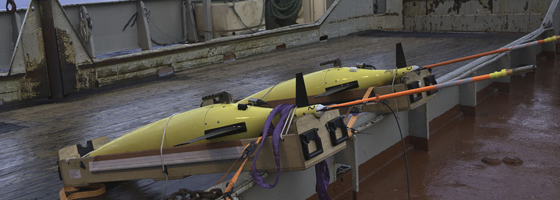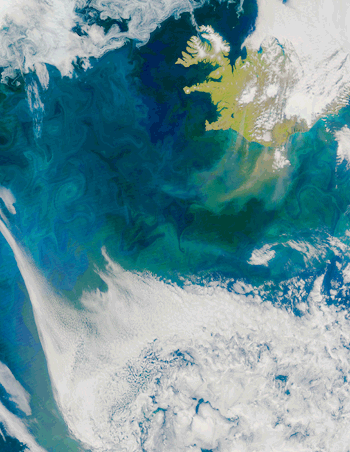Robotic monitoring uncovers North Atlantic Bloom’s secret

Long-term autonomous robotic monitoring helped oceanographers researching the North Atlantic Bloom in 2008 observe that mixing ocean currents cause phytoplankton to bloom earlier than traditionally thought.
Observations from ship voyages and data collected from the long-term robotic monitoring showed that eddies, caused by converging warm and cold ocean currents, push patches of phytoplankton to the ocean’s surface. Prior to the discovery, seasonal sunlight was the generally accepted cause of ocean phytoplankton blooms.
The research is published in the July 6 issue of the journal Science.
Autonomous robots allowed Eric D’Asaro, a professor of oceanography at the University of Washington, and his team to investigate the cause of the bloom in a new physical way. The robots submerge to collect data on plant life then surface and transmit information back to researchers at the University of Washington through Iridium modems sourced from satellite phones.
Craig Lee, associate professor of oceanography at the University of Washington, and Mary Jane Perry, professor of oceanography at the University of Maine deployed four Sea Glider robots and one Lagrangian float into the North Atlantic near Iceland in April of 2008.
The five robots, which were developed and built at the University of Washington, traveled together monitoring temperature, salinity, oxygen, light, chlorophyll, nitrate, light attenuation and optical backscatter.
 The robots’ ability to stay in the ocean and collect large amounts of data over long periods of time was essential for monitoring the large-scale North Atlantic Bloom, Lee said. Phytoplankton blooms at varying times each year, and the bloom is generally patchy throughout the North Atlantic, making it difficult to track.
The robots’ ability to stay in the ocean and collect large amounts of data over long periods of time was essential for monitoring the large-scale North Atlantic Bloom, Lee said. Phytoplankton blooms at varying times each year, and the bloom is generally patchy throughout the North Atlantic, making it difficult to track.
Typically, research crews have to monitor phytoplankton from ships. Rough waters add an element of danger to ship voyages in the North Atlantic, but Lee said robots are unaffected by inclement seas.
Research vessels are also time-limited and expensive at $20,000 to $40,000 per day to operate, D’Asaro said. At those costs, “It doesn’t take long before you can buy a robot,” he said.
Sea Glider Robots, built at UW and sold through iRobot Corporation, sell for around $100,000.
The Lagrangian float tracks phytoplankton by following one patch of the organisms through ocean currents. “One way to think about this is by considering a small parcel of water that contains phytoplankton,” Lee said. “The parcel moves with ocean currents, and the plankton move with it. The float is designed to move with the water parcel.”
The float is an aluminum tube with a wall thickness chosen specifically to expand and contract to aid neutral buoyancy. A computer-controlled piston inside regulates air volume and keeps the float at a fixed depth. The float’s name comes from the Lagrange multiplier used to calculate volume of internal air that will achieve neutral buoyancy depending on depth. D’Asaro said it was a challenge to get the computer to regulate buoyancy because it must always be precise. The float weighs 50 kilograms and the computer must regulate buoyancy to a gram or less.
The robotic equipment was able to stay out to sea for more than a month thanks to modern computer technology. D’Asaro said the microelectronics used in both types of robot use little energy.
Researchers went on a second voyage in May of 2008 to collect data by hand and to check in on the robots. They took additional data from nine years of information recorded by Argo floats that are dispersed in the ocean to monitor temperature and salinity. Satellite imaging was also used to monitor chlorophyll content in the area of research.
Researchers gave the data to Amala Mahadevan, an associate scientist with the Woods Hole Oceanographic Institution, and she created a computerized model of the trends recorded by the robots.
Both Lee and D’Asaro said phytoplankton growth cycles are important to monitor because the small organisms are the bottom of the ocean food chain and affect many sea creatures. Phytoplankton also consumes large amounts of carbon dioxide and produce oxygen. Both scientists said climate change was likely a factor in the early bloom.
Much is still unknown about the ocean but autonomous robots open a window to observing how ocean physics relate to ocean biology. “We really think this is the future,” D’Asaro said.
Image credit: Applied Physics Laboratory, University of Washington





0 comments